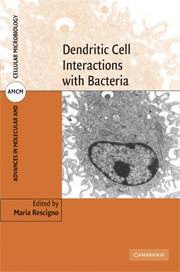Book contents
- Frontmatter
- Contents
- Preface
- List of Abbreviations
- List of Contributors
- I Dendritic cells and their role in immunity
- II Dendritic cells and innate immune responses to bacteria
- 4 Dendritic cell activation and uptake of bacteria in vivo
- 5 Role of dendritic cells in the innate response to bacteria
- 6 Interactions between natural killer and dendritic cells during bacterial infections
- III Dendritic cells and adaptive immune responses to bacteria
- IV Dendritic cells and immune evasion of bacteria in vivo
- Index
- Plate section
- References
5 - Role of dendritic cells in the innate response to bacteria
from II - Dendritic cells and innate immune responses to bacteria
Published online by Cambridge University Press: 12 August 2009
- Frontmatter
- Contents
- Preface
- List of Abbreviations
- List of Contributors
- I Dendritic cells and their role in immunity
- II Dendritic cells and innate immune responses to bacteria
- 4 Dendritic cell activation and uptake of bacteria in vivo
- 5 Role of dendritic cells in the innate response to bacteria
- 6 Interactions between natural killer and dendritic cells during bacterial infections
- III Dendritic cells and adaptive immune responses to bacteria
- IV Dendritic cells and immune evasion of bacteria in vivo
- Index
- Plate section
- References
Summary
INTRODUCTION
Innate immunity is an ancient and highly conserved system that provides the first line of defense upon encounter with pathogenic organisms. Activation of innate immune responses is a complex process involving multiple components and distinct steps. The cellular components of innate immunity include neutrophils, monocytes, macrophages and dendritic cells (DCs). These cells are capable of direct microbicidal activity that partially depends on inducible nitric synthase (iNOS) and NADPH oxidase complex that catalyze production of toxic anti-microbial compounds. Additionally, they secrete a vast array of pro-inflammatory mediators such as cytokines and chemokines and can recruit and activate other inflammatory cells, thus amplifying the immune cascade. Apart from their role in restricting microbial growth, innate immune responses also provide the inflammatory context in which adaptive T- and B-cell immune responses develop.
Dendritic cells are derived from hematopoietic progenitor cells in the bone marrow and are found in the peripheral circulation as well as in the lymphoid and non-lymphoid tissues. Dendritic cells can be subdivided into several subsets based on the expression of the cell surface markers and different subsets have been ascribed distinct functions during the immune response. Since their discovery, dendritic cells have been studied extensively with regard to their role as antigen-presenting cells. However, it is becoming increasingly clear that dendritic cells also play an important role during the innate immune responses to microbial pathogens.
- Type
- Chapter
- Information
- Dendritic Cell Interactions with Bacteria , pp. 99 - 118Publisher: Cambridge University PressPrint publication year: 2007

